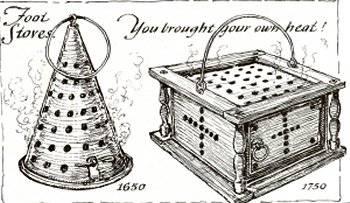![]()

Foot Warmers for Church Use
The first church was called a meeting house and it resembled exactly that. It was used for all sorts of town meetings during the week, and it became a church only at sundown on Saturday, when The Sabbath started, and it lasted until sundown on Sunday.
Sunday night was not the quiet eve that it is today, for as soon as sundown occurred, fasting ended and the partying began. Because no cooking or other utilitarian work was allowed during the Sabbath, the mothers labored all day Saturday, but stopped at the moment the sun dropped below the lorizon.
Churches were unheated primarily because of the dread of accidental fire. Thee were no chimneys in the early church buildings. In any event an open fire built in a large building that had been closed overnight during winter would do little more than start to thaw the walls out.
Church services used to start at nine in the morning and lasted until dusk, and because of the town vote, no lights were allowed in most early churches. The first lights in church buildings appeared about 1820. The first stoves were installed at about the same time, but against much protest.
Churches were the coldest houses in town during the early days, and many preacher's winter diary included such a phrase as "bread was frozen at the Lord's Table today." Bread used in celebration of the Lord's Supper ws kept in a charcoal heater in most Maine churches to keep it from freezing. Baptismal water was kept under the parson's coat in a warm flask.
Excerpted by Maury Tosi
From Eric Sloane's booklet American Yesterday (1956)